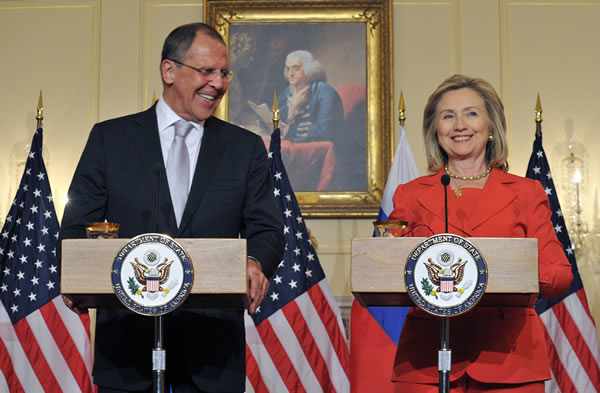Russian Foreign Minister Visits U.S., but Troubles Remain Hidden
Robert Nicholson /
This week, Russia’s foreign minister, Sergei Lavrov visited Washington to sign agreements on child adoption, visas, and nuclear safety. In reality, however, what Hillary Clinton and the Obama Administration are hailing as symbols of closer cooperation between the two countries are only a façade to cover up the lack of progress on the more critical issues dividing the two countries: Iran, missile defense, and human rights.
Lavrov and Clinton both agreed that it is time for Libyan leader Muammar Qadhafi to go. In Lavrov underscored that the Libyan leader should relinquish power. This is good news—and a volte-face—after Russia (and before that, the USSR) supported the anti-Western Libyan leader for decades.
The two also had discussions on Syria, Yemen, Russia’s potential WTO accession, and the Israeli–Palestinian conflict. Russia refuses to abandon another authoritarian Arab leader, Bashar al-Assad, fearing both chaos and the loss of a naval base and an arms market. Moreover, the U.S. achieved little success on the most important problems plaguing the Obama Administration’s “reset” policy: European missile defense and Iran.
Lavrov stated that missile defense remains “the biggest irritant” between the two countries. Russia has insisted that the U.S. allow Russia to have direct operational control of missile defenses and provide legally binding guarantees that these systems are not targeted toward Russia. It appears that two sides did not achieve much progress.
Clearly, the U.S. cannot afford to allow Russia to dictate to us and our allies how to defend ourselves from ballistic missiles . As Heritage Research Fellow Baker Spring recently pointed out, the U.S. and Europe need to move Russia toward a different agreement that confirms “the right of all states to defend themselves against strategic attacks.” Russia should not have operational control over a U.S./NATO missile defense in Europe.
Policy toward Iran has been another source of tension. On Wednesday, Lavrov presented a “step-by-step” program to incentivize Iran to respond to global concerns about its nuclear program through “gradual easing of sanctions.” This is a non-starter. As Heritage Senior Research Fellow Ariel Cohen wrote last year, Russia’s Iran policy is a real challenge for the Obama Administration in which Russia’s interests in Iran greatly diverge from America’s. The Obama Administration needs to understand that Russia will provide only marginal assistance on Iran because Russia has too many entangled interests there. After a joint sanctions vote in the U.N. Security Council, Russia is trying to ease pressure on Tehran.
In his meeting with Obama, Lavrov addressed the congressional legislative initiative to pass the Sergey Magnitsky Rule of Law Accountability Act. It commemorates a brave whistle-blowing Russian lawyer who worked for a U.S. law firm. Magnitsky exposed massive fraud by Russian officials, was arrested, and died in custody. The Russian Presidential Human Rights Committee recently announced that Magnitsky was denied medical treatment while in jail and may have died as a result of beatings.
The two sides also discussed Russia’s accession to the World Trade Organization. The President reaffirmed his strong support for Russia’s efforts to complete its accession process this year and discussed the necessity of granting Russia permanent normalized trade relations—something that Congress may reject, as the Jackson–Vanick Amendment, passed in 1974, still applies.
Clinton and Lavrov want to paint this trip as a sign that the “reset is working,” and the Obama Administration has put on a grand show this week to make that point. However, with problems still lurking behind this week’s façade, the Obama Administration must tend to American interests and rethink the “reset.”
Robert Nicholson is a member of the Young Leaders Program at The Heritage Foundation. Click here for more information on interning at Heritage.

